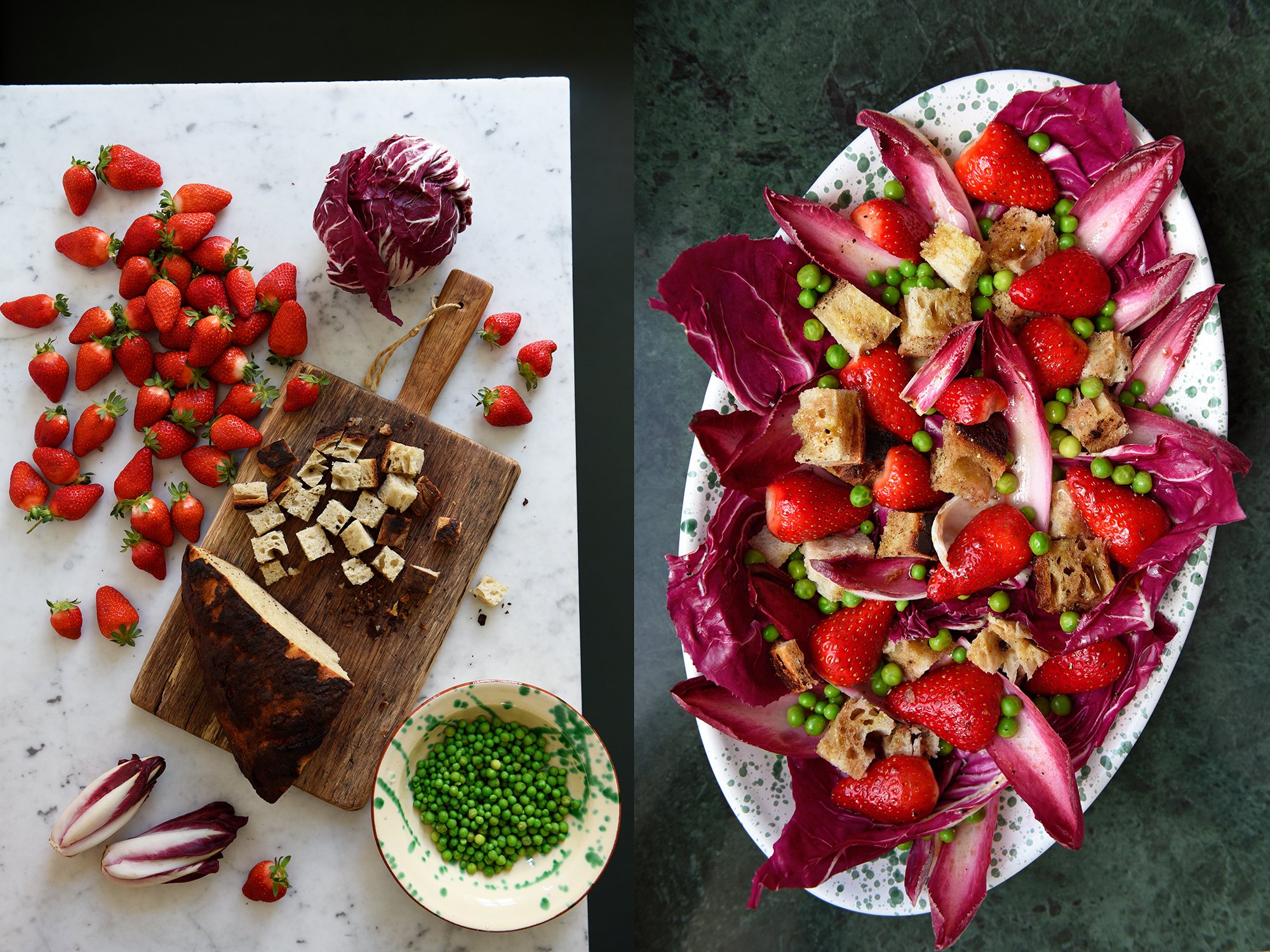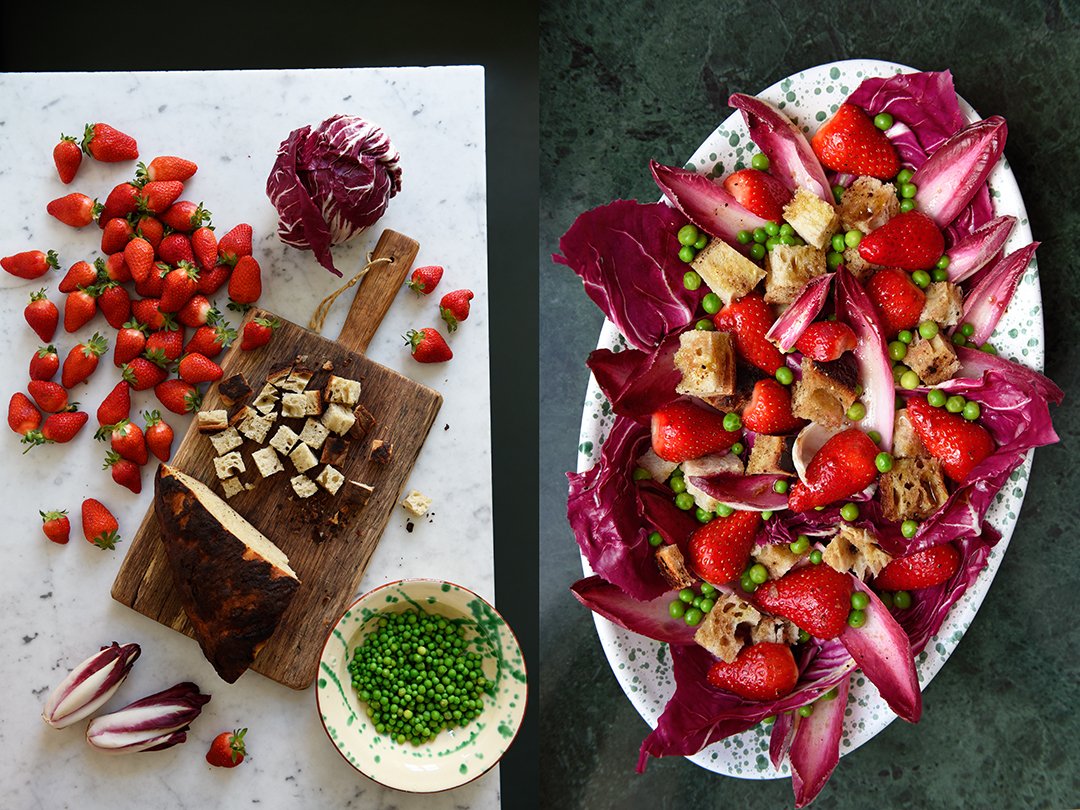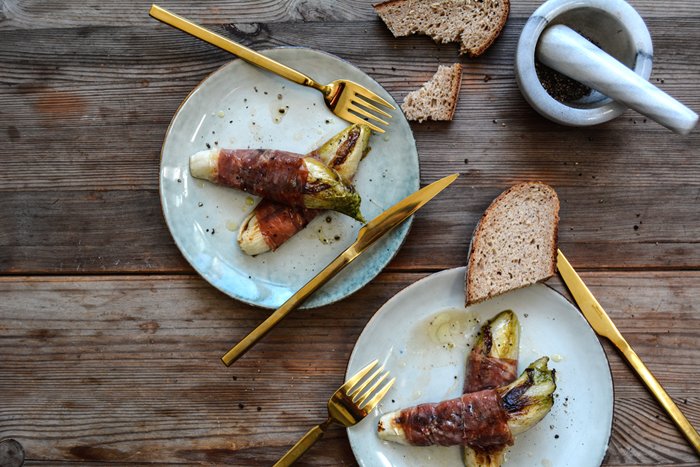Summer Panzanella
I fell in love with panzanella when I was about five or six years old. We used to spend our summers in Tuscany, in a tiny old town close to Lucca. These holidays sparked my forever longing for the Mediterranean, for its pure and simple way of cooking, and for salads made with old bread. The taste of stale bread, soaking up the oily juices of a dark vinaigrette, tossed with deep red, ripe tomatoes and fleshy basil leaves became a memory so strong that it shaped my palate and my future cooking as an adult.
It was then that, without consciously noticing, I understood that a handful of good produce and products can create magic on a plate. It wasn’t luxurious, it was frugal, it wasn’t labor-intensive, it was very easy to prepare. And it was adventurous: I picked the tomatoes together with my Mama from the vegetable garden behind the house where we stayed. The garden, picking vegetables under the burning hot Italian sun, using old/ stale bread and not wasting it, preparing the dish together with my mother, bare-footed on clay tiles, setting the table with colorful, heavy Tuscan ceramics - all this became me, as a cook and as a person.
Now, you can find theses ceramics in my kitchen in Berlin, and although I don’t have a vegetable garden, my cooking is still very much produce-based and circling around comforting and frugal dishes (more and more even these days). And my love for panzanella is unbroken, as strong as ever.
So during our holidays in Tuscany, we ate the basic version with tomatoes and basil almost every day. Over the years, I’ve tried other recipes, with fish and seafood even, but I find that bread salads focussing on fresh vegetables excite me the most. I also like to add fruit sometimes. I even have three panzanella recipes in my book 365, with cherries and Stilton, one with berries and bacon (you can find the link below), and there will be a couple more in my new book NOON (not the one I’m sharing today).
Very often (when I’m not working on a cookbook), I don’t plan the recipe in advance but just look in my fridge and on the kitchen counter and then decide what kind of panzanella I’ll throw together. Just leftovers, staying frugal, and true to its core.
So when I had a loaf of sourdough bread lying around, slowly losing its sponginess (I never use completely stale bread for my panzanella, as you’d have to soak it in water first, which I don’t like), I knew what I would turn that into. Crisp leaves of radicchio and red Belgian endive - yellow endive works just as well but I love the drama that the red one adds - bring in a bitter note, green peas and ripe strawberries make it sweet and juicy. Stilton would have fit too (it always fits) but there was none in the fridge, so I went back to my panzanella roots: work with what you have right in front of you.
Here’s the recipe for my Berry and Bacon Panzanella with Rosemary.
MY NEW BOOK
NOON: Simple Recipes for Scrumptious Midday Meals and More
ON SALE SEPTEMBER 2023
YOU CAN PRE-ORDER NOON HERE
Support local: pre-order from your neighborhood bookstore
Summer Panzanella
Serves 1
For the salad
1 small handful fresh or frozen peas
3 large radicchio leaves, torn
1 red or yellow Belgian endive, leaves separated
8 ripe strawberries, hulled and cut in half
1 large, thick slice of white bread (ideally sourdough bread), cut into chunky cubes
For the dressing
3 tablespoons olive oil
1 tablespoon balsamic vinegar
1 tablespoon white balsamic vinegar
fine sea salt
ground pepper
For the salad, bring salted winter in a small saucepan to a boil and blanch the peas for 1 minute. Drain the peas, briefly rinse with cold water, and let them cool for 2 minutes then set aside.
For the dressing, whisk together the olive oil and both vinegars in a small bowl and season to taste with salt and pepper.
On a large plate or platter, layer the radicchio leaves, the whole Belgian endive leaves, strawberries, bread, and peas. Drizzle with the dressing and enjoy immediately (which I do) or let it soak for 15 minutes.
Sautéed Belgian Endive wrapped in Prosciutto di Parma
The lack of time can be as fruitful as frugality. My mind tends to work quicker - and come up with surprisingly good ideas - when I don't have time and ingredients in abundance. It makes me creative. My boyfriend often asks me what we should cook for dinner in the early afternoon. In the past, I would have just gone to the grocery store if I hadn't made up my mind yet, I would have looked at the fresh produce and gone back to my kitchen to start cooking. But that's not possible at the moment, I'm lucky if I manage to do my beloved grocery shopping once or twice a week. Time is a gift that I never treasured as highly as I do right now.
But I don't want to complain, it's a different kind of cooking, but nonetheless inspiring and still very satisfying. Like these little golden bites of Belgian endive (chicory), sautéed for just a couple minutes until golden and then wrapped in a thin layer of prosciutto di Parma. It was delicious! In my pre-cookbook life I would have made a side out of it and not given it my full attention, or at least bought a fresh loaf of ciabatta to dip into the juices in the pan. But no, a few slices of my leftover spelt bread where just as good and the simplicity of this meal caressed my taste buds.
Sautéed Belgian Endive wrapped in Prosciutto di Parma
Serves 2
olive oilmedium
Belgian endive, trimmed and cut in half lengthwise, 2
fine sea salt
prosciutto di Parma 4 thin slices
black peppercorns, crushed in a mortar
In a small, heavy pan, heat a splash of olive oil over high heat and sauté the endives for 1-1 1/2 minutes on each side, or until golden brown and still al dente. Season lightly with salt and take the pan off the heat.
On a large plate, spread the prosciutto di Parma and wrap each half of Belgian endive tightly in one slice of prosciutto. Put the pan back on the heat and cook the wrapped endives for 1 minute on each side or until the prosciutto is golden but still soft. Divide between plates and sprinkle with crushed pepper.













